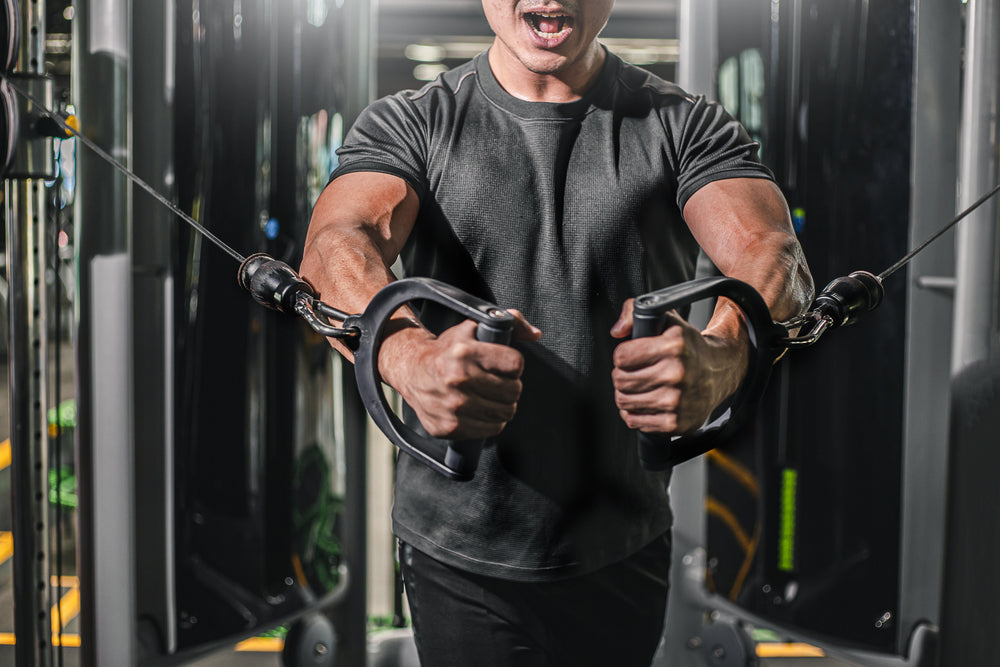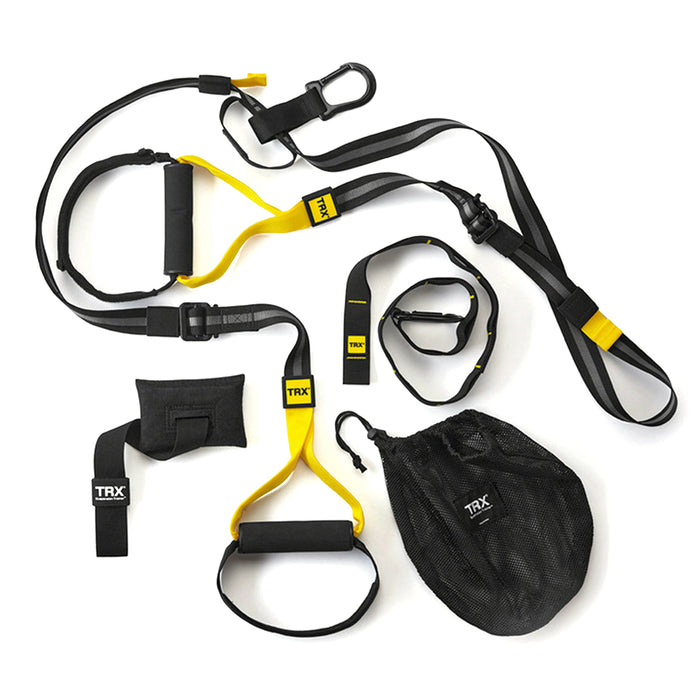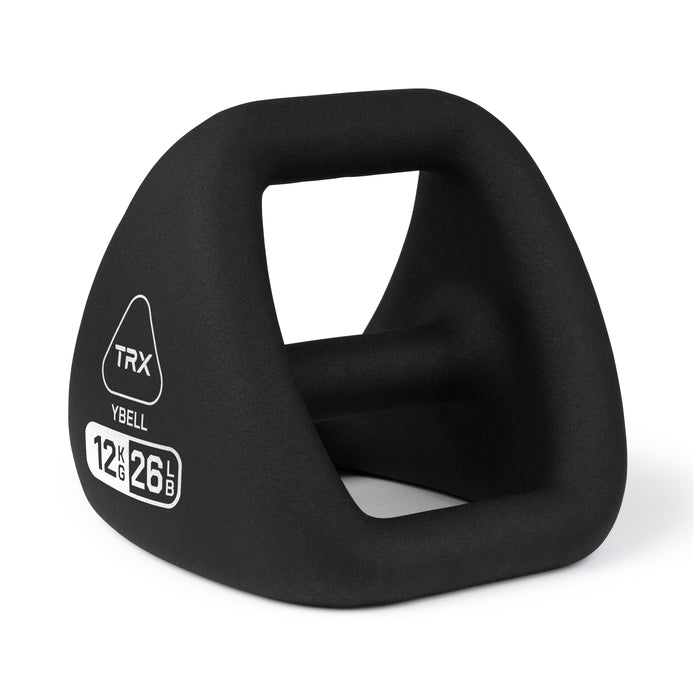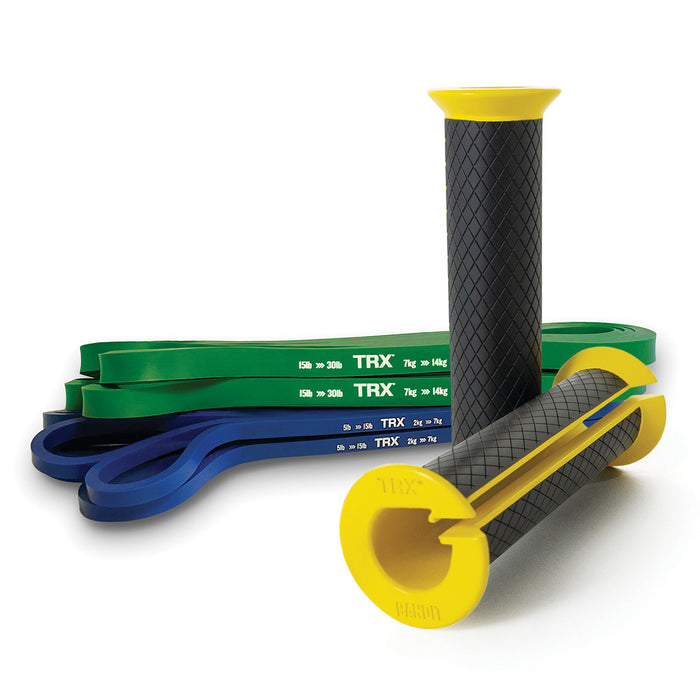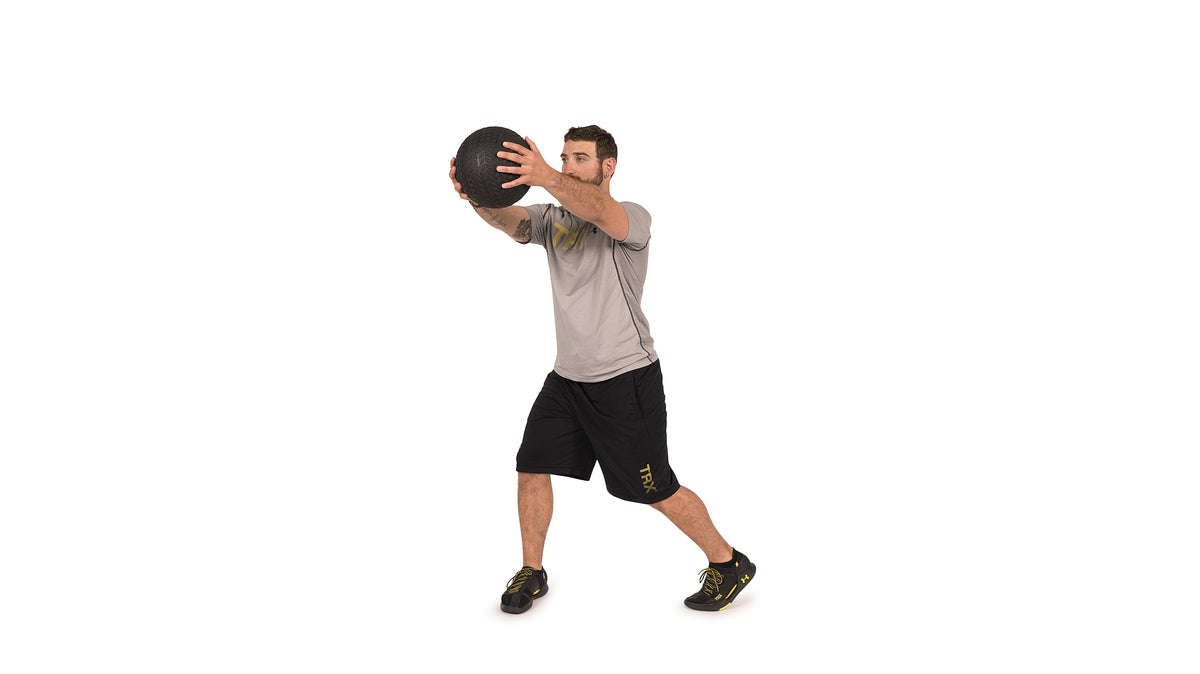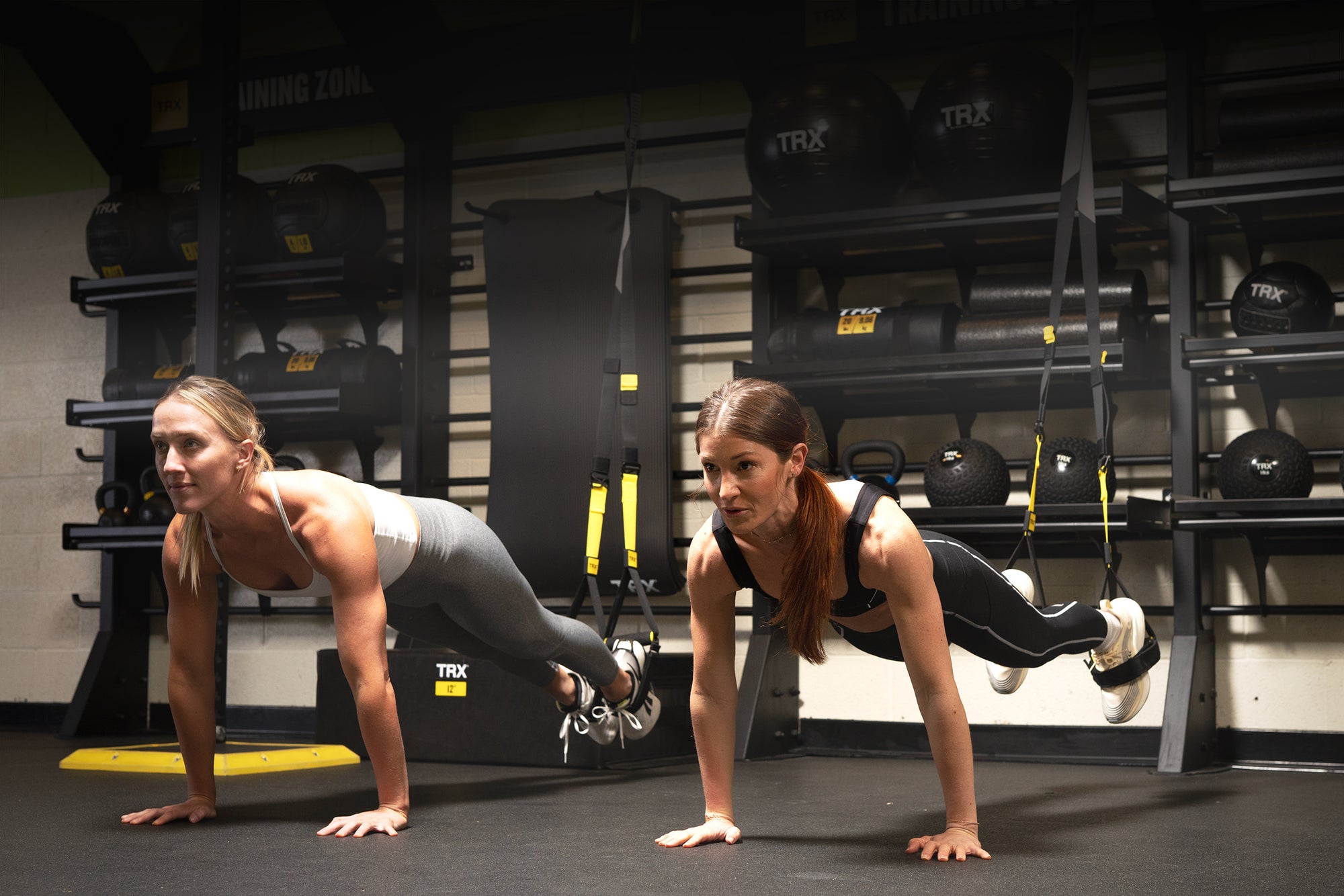When it comes to training the chest, our mind immediately conjures up images of someone lying on a bench, pressing a barbell loaded with plates or a set of enormous dumbbells up above their torso. But what if we told you that there’s a highly effective way of building bigger and stronger pecs that doesn’t involve either of these things? Say hello to cable chest exercises, a vastly untapped world of variety and additional benefits to add into your chest training regime.
Why Should You Do Cable Chest Exercises?
Cable chest exercises offer a number of considerable benefits over and above the traditional barbell or dumbbell bench press. Here are some of the key ones to look out for:
- Improved shoulder stability & mobility: Cable exercises are fantastic for targeting many of the smaller stabilizing muscles around the shoulder joint, which is a key structure in chest-focused pressing movements
- Safer & less stressful for joints: Cable chest exercises tend to place less load, and therefore less stress, on your joints than bench pressing or chest pressing. So, these are perfect for anyone with a pre-existing injury or weakness in this area–or someone looking to rehab before moving back to their typical weight
- Improved posture & core strength: Most cable exercises target your back and core because the majority of exercises are performed in a standing position. This will strengthen the muscles that support your spine and your shoulder blades, all of which will have positive carry-over to other full-body exercises and general improvements in posture (for a killer TRX chest / full body workout, check out this tasty little superset involving the TRX Atomic Push-up and a Kettlebell Swing!)
- Elicit a better / more targeted pec contraction: You get a more effective pump when you’re able to isolate the chest muscles. Cable exercises are an effective way to target the chest specifically, so they’re perfect for refining the shape and structure of the chest. Cable chest exercises are also a great option for ‘superset training’ when combined with a compound movement such as barbell or dumbbell chest press
- Eliminate imbalances: Cable exercises work unilaterally. For example, they provide isolated resistance to both sides of the body at once. Therefore, it’s impossible for one arm/side to compensate for any weaknesses in the other. This helps build stability and also keep one side from being stronger than the other.
- Increased time under tension: The constant resistance from the cables means that it is impossible to rest completely until every set is complete. This creates far more time under tension in each exercise and, therefore, has a greater hypertrophic (muscle building) effect (Wilk, M., Zajac, A. & Tufano, J.J., 2021)
The Best Cable Chest Exercises to Try Today
Now that we've covered the benefits of cable chest exercises, let's dive into some of the most effective movements for building chest strength and definition. (Want to find the perfect cable exercises for your fitness level and goals? Our quick assessment quiz can create a personalized chest training plan just for you!) These versatile exercises have helped countless fitness enthusiasts develop impressive chest development.
TAKE OUR TRAINING QUIZ
11. Cable Crossover
Cable crossovers are a staple chest exercise and you’ve probably seen people doing this exercise at your gym. The benefits of cable crossover are that it tests your shoulder and chest strength at the end range of motion. This causes a deep pec contraction to develop a sharpened chest.
How to Do:
- Stand in the centre of the machine with feet shoulder-width apart, taking hold of a handle in each hand
- Bend your torso forwards slightly, keeping your spine neutral and back straight, and bend your elbows slightly as well, with your wrists facing the floor
- Keeping your core engaged, pull both handles down and across your body to squeeze the pecs together
- Slowly open the arms and return the cables to the start position
10. Seated Cable Chest Press
Because you’re sitting down, seated cable chest press offers a stable position from which to safely achieve a good chest workout. Furthermore, this exercise mimics familiar movements such as dumbbell bench press so it’s great for beginners.
How to Do:
- Sit with your back firmly supported against a bench
- Grasp the cable handles and position your hands level with your mid-chest region, positioning your feet firmly on the floor to stabilize your body
- Brace your core to stabilize your spine and perform a pressing movement, extending your arms forward until your elbows are fully extended, but not locked, maintaining contact with your back and shoulder blades against the backrest
- Pause momentarily, then slowly return to your starting position, allowing your elbows to bend in a slow, controlled manner
9. Standing Cable Chest Press
The other variation of the cable chest press is the standing cable chest press. You guessed it. You’re no longer sitting down during this exercise. Due to the standing position, you’ll be using your core and focusing on posture more. The exercise also focuses on building your shoulder joints and rotator cuffs.
How to Do:
- Stand between the cables and set the handles to shoulder height, before facing away from the machine and grasping one handle in each hand in an overhand grip (palms facing down)
- Step forward and plant your feet in a split stance with one foot forward and one back, ensuring that your feet are slightly further than shoulder-width apart
- Brace your core to stabilize your spine and perform a pressing movement, extending your arms forward until your elbows are fully extended, but not locked, and your hands come together, ensuring that the cables are running over your shoulders rather than under
- Pause momentarily, then slowly return to your starting position, allowing your elbows to bend in a slow, controlled manner to bring the handles back towards your shoulders
8. Flat Cable Flys
Flat cable flys stretch the chest muscles under a constant load. Because of the consistent pressure with this exercise, you can effectively build more chest muscle. Combine this with
‘Combo #2’ in this TRX Workout for some top notch TRX alternatives to the cable fly
How to Do:
- Position a flat bench between two low pulleys so that when you are laying on it, your chest will be lined up with the handles
- Grab each handle with a palms up (supinated) grip, lay flat on the bench and keep your feet on the ground
- Extend your arms out to your sides with a slight bend in your elbows, so your arms are parallel to the floor. Lift the arms in a semi-circle motion directly in front of you by pulling the cables together until both hands meet at the top of the movement
- Hold the contraction for a second at the top, with your arms perpendicular to your torso, before slowly returning to the starting position
7. Cable Incline Press
The cable incline press offers an alternative angle for training your pecs. In doing so, you’ll be able to target the upper chest and shoulders. Like the seated cable chest press, its stable lying position makes it safe for beginners to use in their workouts
How to Do:
- Place a bench in the middle of two low pulleys at a 45º angle with the pulleys at the bottom of the cable crossover station (ensure the bench is positioned so that when you grab the handles the resistance is in line with your chest)
- Grab each handle with a palms up (supinated) grip, lay flat on the bench and keep your feet on the ground - position the handles at the side of your chest, tucked in a little with a 90º bend in your arms
- Press out and extend your arms to move the handles up and inwards until your hands meet at the top
- Squeeze your chest at the top of the movement and then inhale as you slowly release back to the starting position
6. Single Arm Seated Cable Press
Single arm seated cable press addresses any imbalances by working one side at a time. The exercise also helps with motor control and overall coordination of your body.
How to Do:
- Start seated on a bench with the cable head in a low-middle position
- Grab a cable with one hand and pull in towards your body so it sits at mid-chest height
- Start by pressing your arm away from you until your arm is locked out and fist facing away from you
- Hold the contraction for a second at the top before slowly returning to the starting position
5. Unilateral Cable Press
The unilateral cable press’s benefits are pretty similar to the single arm seated cable press. This exercise helps with fixing imbalances in the body by working on one side at a time. However, unilateral cable press’s are also great for working the core and can improve posture.
How to Do:
- See ‘9. Standing Cable Chest Press’ for setup and starting position
- Rather than pressing both arms out at the same time, simply press one out in front of you while holding the other next to the body
- After you’ve performed a rep on one side and returned to the start position, press the other arm, maintaining an engaged core throughout
4. One Arm Cable Crossover
One arm cable crossovers are a one-stop shop exercise. The movement requires you to stay balanced and, as a result, your core is engaged and you learn to build petter posture. Furthermore, the exercise elicits a deep pec contraction to help develop a shapely chest.
How to Do:
- See ‘11. Cable Crossover’ for setup and starting position, just using one side of the cable machine
- Pull down on the handle until your hand reaches the midline of your body and you feel a squeeze in the pec
- Pause momentarily at the bottom before bending the elbow and returning the handle up to chest / shoulder height
3. Cable Bench Press
Cable bench presses are a great exercise for beginners because it mimics the popular dumbbell bench press. Its stable lying position also makes it safe, because your range of motion is only limited to a couple movements.
How to Do:
- Position a flat bench between two low pulleys so that when you are laying on it, your chest will be lined up with the handles
- Grab each handle with an overhand grip (knuckles up towards the ceiling), lay flat on the bench and keep your feet on the ground, pulling the handles so they rest at the side of your chest.
- Press both handles up above the torso and bring the hands together at the top to get a squeeze in the pecs
- Pause momentarily at the top before bending the elbows and returning the handles to the side of the chest
2. High-to-Low Cable Flys
Mind-muscle connection is key for building strength and muscle mass. High-to-low cable flyers are one of the best exercises for isolating your chest. You can build shape and definition as well, thanks to the full range of motion incorporated into the exercise.
How to Do:
- Set both pulleys as high as possible, set the desired weight, grasp both handles with a neutral grip and take a step forward into a split stance
- Pull the handles so there is tension on the cables and the arms are out to the side of the body at around shoulder height, with a slight bend in the elbows
- Move entirely at the shoulder joint and slowly bring the arms down in front of you towards waist height
- Squeeze the pecs together at the bottom of the movement before opening the arms to return to the start position at shoulder height
1. Low-to-High Cable Flys
Low-to-high cable flys use the reverse movement of high-to-low cable flys. This exercise also provides the same benefits as the exercise above.
How to Do:
- Set both pulleys as low as possible, set the desired weight, grasp both handles with a slightly supinated (palms up) grip and take a step forward into a split stance
- Start with a slight bend in the elbows and your arms out at a 45º angle to the body. Moving entirely at the shoulder joint, lift the handles up and out in front of you while maintaining a neutral spine until both handles touch at around chest height
- Pause for a second at the top of the rep to squeeze the pecs, then slowly allow the arms to open and return to the start position.
Try one of our TRX products for your workout today:
Try These Cable Chest Workouts
Now, using the eleven exercises highlighted above, here are three of the best cable chest workouts you can incorporate into your split. The beginner workout helps you understand the movements required to build strength. The intermediate cable chest workout incorporates your core, while the advanced cable workout challenges your full range of motion. Try them today!
Beginner Cable Chest Workout
This workout is designed to mimic the dumbbell (or barbell) bench press and dumbbell fly movements, which most beginner gym-goers will be familiar with. Mastering these fundamentals of cable chest exercises is a good starting point before before exploring the wider possibilities:
- A1 - Cable Bench Press x 8-10
- A2 - Flat Cable Flys x 12-15
- Perform these two exercises as a superset (one directly after the other) for three sets
- Aim to have a heavier weight for A1, then a lighter weight for A2 - try to keep these weights consistent for both exercises across all three sets
- Take 60-90 secs rest between each set
Coaches Tip: Once you’re comfortable with these movements, try adding a strict tempo of 3 seconds to the eccentric (lowering) phase of each rep to increase the time under tension (T.U.T.) and thereby increase their hypertrophic (i.e. muscle building) effects
Intermediate Cable Chest Workout
This workout is designed to provide an additional stability / core element by removing the support of a bench. It also begins to introduce the variety of angles through which you can train on the cable pulley machine to target specific parts of the chest:
- A1 - Standing Cable Chest Press x 12-10-8-6
- Perform this as a standalone exercise for four sets in the descending rep pattern shown above, aiming to increase the weight with each set
- Take 60-90 secs rest between each set
- B1 - High-to-Low Cable Flys x 10
- B2 - Low-to-High Cable Flys x 10
- Perform these two exercises as a superset (one directly after the other) for three sets x 10 reps on each
- Take 60 secs rest between each set
Coaches Tip: Aim to establish whether your high-to-low or your low-to-high cable fly is stronger to identify any imbalances or weakness in a particular range of motion. Then you can work on rectifying this as you train with the cables more
Advanced Cable Chest Workout
Once you’ve progressed through Beginner and Intermediate stages, you’re ready to challenge your muscles and joints under load through their greatest range of motion, and with the lowest level of stability. This workout introduces both of these elements to truly level up the intensity and ensure continued progress
- A1 - Cable Crossover x 10
- A2 - Unilateral Cable Press x failure
- A3 - Single Arm Crossover x failure
- Perform these three exercises as a ‘tri-set’, i.e. all three exercises back to back
- Beginning with the bilateral (two limbs) Cable Crossover in A1, you then move to the unilateral (single limb) exercises in A2 and A3
Coaches Tip: Aim to work to failure on A2 and A3 to truly exhaust the muscle group and achieve that level of intensity you're after

How to Progress Your Cable Chest Workouts
Once you’ve mastered the basics of the cable chest exercises, you can start to play around with weights and reps to suit your training goal and take your workouts to the next level; think higher volume, lower weights for hypertrophy, and vice versa for strength-focused sessions.
In summary, if you’re looking for a way to ‘bulletproof’ your shoulder joints, improve your posture, eliminate imbalances and achieve a truly beautiful and functional chest, be sure to visit the cable machine next time you’re in the gym and reap the rewards that follow!
Tom Cuff-Burnett
References:
https://link.springer.com/article/10.1007/s40279-021-01465-2
CITATION: Wilk, M., Zajac, A. & Tufano, J.J. The Influence of Movement Tempo During Resistance Training on Muscular Strength and Hypertrophy Responses: A Review. Sports Med 51, 1629–1650 (2021)

